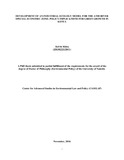Development of an Industrial Ecology Model for the Athi River Special Economic Zone: Policy Implications for Green Growth in Kenya
Abstract
Kenya Vision 2030 currently guides the country’s development agenda. It recognizes industrialization as one of the key pillars of economic growth and wealth creation. As a result, there has been a marked increase in the development of special economic zones (SEZs) across the country. Through inter-company exchange of wastes and by-products, SEZs can reduce negative environmental impacts that emanate from industrial consumption of raw materials, energy and water, hence decoupling accelerated growth from environmental degradation. There is need to transform the country’s SEZs into low-carbon, resource efficient, climate resilient, and socially inclusive units that are competitive in attracting green foreign direct investments (FDI). The overall objective of the study was to assess the efficacy of Industrial Ecology (IE) model in enhancing the environmental governance of the Athi River SEZ. The study characterized production clusters of the SEZ; analyzed material flows; assessed environmental performance; and using the IE approach, proposed a governance model for the zone. A mixed methods approach was used with both qualitative and quantitative data being generated from primary and secondary sources. Primary data was obtained through Key informant interviews of factories and zone management personnel; factory production volume baseline analysis; inspection of the factory’s procedures and practices; and identification of waste and by-products. Resource Flow Analysis was used to quantify material and energy flows in different clusters. Secondary data was obtained through the review of utility records and production reports. The study revealed an unregulated evolution of industrial symbiosis (IS) at the zone in four clusters. These comprised use of (i) 240 tons/year of seed cake by-product as raw material for animal feed manufacturing leading to 80% secondary transport energy savings and 86,427 kg CO2e/year of reduced emissions; (ii) 108 tons/year of tarpaulin waste as raw material for making plastic water tanks leading to the creation of five on-site plastic reprocessing green jobs; (iii) 255 tons/year of textile fabric off cuts for making sofa sets and on-site steam generation leading to the creation of fifteen green jobs and 9% avoided emissions (1,142 kg CO2e) and (iv) 204 tons/year of chipboard saw dust waste used as steam boiler fuel replacing fuel oil with 11% avoided emissions (4,448 kg CO2e). Inter-company use of wastes and by-products as raw material inputs reduced the raw material transport costs by over 80% resulting in a lower carbon footprint. Waste reuse diverted the potential solid wastes from the landfill, created new products and jobs, hence contributing to the country’s green growth agenda. However, most of the zone’s material flows were largely linear due to lack of policy and weak infrastructure for waste recovery and reuse. There was no evidence of genuine partnerships with communities; no strategic co-locating of industries that exchange wastes; no functional infrastructure for IE promotion; no IE enabling policies/incentives; and limited commitment to a resource efficient zone. A governance model was developed that (i) creates a multi-stakeholder Green Cell within the Zone Authority with the sole mandate of promoting resource use efficiency through Cleaner Production and IS; and (ii) seeks to strengthen partnerships between industry, government and academic institutions in eco-innovation. The findings of this study forms the basis of the country’s switch from the inefficient linear production approach to an integrated and resource efficient circular economy.
Publisher
University of Nairobi
Rights
Attribution-NonCommercial-NoDerivs 3.0 United StatesUsage Rights
http://creativecommons.org/licenses/by-nc-nd/3.0/us/Collections
The following license files are associated with this item:


